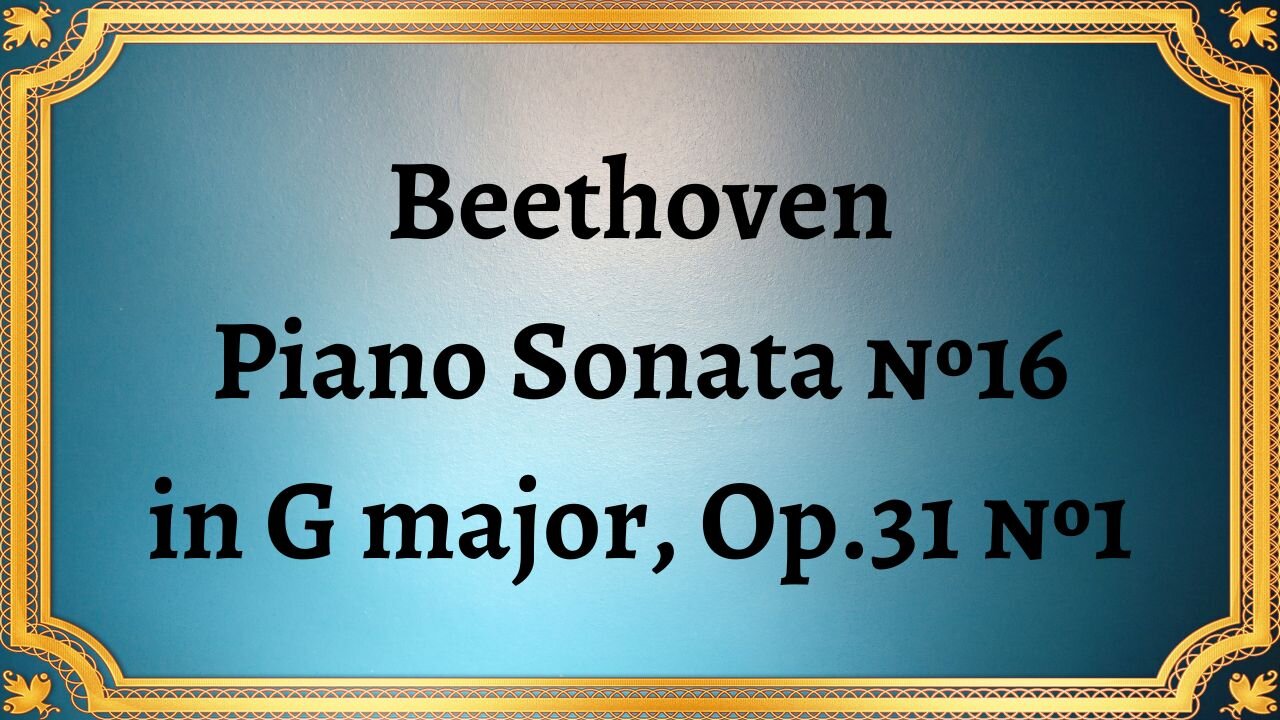Premium Only Content

Beethoven Piano Sonata №16 in G major, Op.31 №1
#classical_music #Beethoven #sonata_for_piano
I. Allegro vivace 00:00
II. Adagio grazioso 05:08
III. Rondo (Allegretto) 16:22
Beethoven Piano Sonata No. 16 in G major, Op.31 No. 1 is a masterpiece composed by Ludwig van Beethoven, a renowned German composer and pianist of the classical era. This exquisite piece of music has captivated audiences for centuries with its melodic brilliance, technical complexity, and emotional depth.
Beethoven composed Piano Sonata No. 16 in G major, Op.31 No. 1 between 1801 and 1802, a period often referred to as his "middle period" or "heroic period." During this time, Beethoven was gradually losing his hearing, which profoundly impacted his personal life and artistic expression. Despite his struggles, Beethoven continued to create groundbreaking compositions that pushed the boundaries of classical music.
Beethoven's Piano Sonata No. 16 follows the traditional three-movement structure of a classical sonata: Allegro vivace, Adagio grazioso, and Rondo. The piece showcases Beethoven's mastery of form, with each movement seamlessly transitioning into the next.
The first movement opens with a lively and spirited theme that showcases Beethoven's signature use of contrasting dynamics and tempos. The second movement, Adagio grazioso, is a lyrical and graceful composition, highlighting Beethoven's ability to evoke deep emotions through delicate melodies. The final Rondo movement brings a sense of joyful energy, featuring playful and syncopated rhythms.
Beethoven's Piano Sonata No. 16 demonstrates his penchant for harmonic exploration. He skillfully incorporates unexpected chord progressions and modulations, challenging the traditional tonal boundaries of the time. This experimental approach contributes to the overall complexity and depth of the piece.
Beethoven's Piano Sonata No. 16 in G major, Op.31 No. 1 remains a beloved and influential composition in the classical music repertoire. Its enduring legacy can be attributed to several factors:
Technical Mastery: This sonata demands a high level of technical proficiency from the pianist, making it a favorite among performers and a staple in piano competitions and recitals worldwide.
Emotional Depth: Beethoven's ability to convey a range of emotions, from exuberance to introspection, has made this sonata a source of inspiration for generations of musicians and music lovers alike.
Cultural Impact: The universal appeal of Beethoven's music transcends time and borders, allowing it to be enjoyed by audiences of diverse backgrounds. Piano Sonata No. 16 continues to be celebrated as a testament to Beethoven's enduring genius.
Beethoven's Piano Sonata No. 16 in G major, Op.31 No. 1 stands as a remarkable testament to the artistic brilliance and innovation of Ludwig van Beethoven. Its melodic beauty, technical complexity, and emotional depth continue to captivate listeners and inspire musicians around the world. By understanding the historical context, musical characteristics, and lasting impact of this extraordinary composition, we gain a deeper appreciation for Beethoven's genius and his profound contributions to the world of classical music.
-
 16:45
16:45
Classical music_Music Inspiration
17 days agoSamuel Barber String Quartet, Op. II
552 -
 32:15
32:15
DeVory Darkins
7 hours ago $2.77 earnedDemocrats PAINFULLY WRECKED by Tom Homan as paid protesters ERUPT in Chicago
2.48K19 -
 16:59
16:59
Degenerate Jay
11 hours agoIs Metal Gear Solid Delta: Snake Eater Worth Buying?
1842 -
 LIVE
LIVE
Flex011
4 hours ago $0.03 earnedCronos: The New Dawn – Brutal Time-Travel Horror Survival
39 watching -
 33:11
33:11
The Finance Hub
15 hours agoBREAKING: JD VANCE JUST RELEASED A MASSIVE BOMBSHELL!!! OMG!!
2088 -
 18:06
18:06
Professor Gerdes Explains 🇺🇦
14 hours agoAfter Major Attack, Trump Vows "Phase II" Sanctions on Russia
314 -
 LIVE
LIVE
EVASIVE_rabbi
4 hours ago✅️ 2 Dumb Navy Vets & A First Playthrough #Coop ✅️
68 watching -
 LIVE
LIVE
Cook14u
8 hours agoSeahawks Let Me Down, DO NOT Talk About How I Look 🤐🙃🥴
18 watching -
 8:18
8:18
MattMorseTV
14 hours ago $8.16 earned2.2 MILLION in ONE YEAR.
60.7K144 -
 LIVE
LIVE
TheKappaConvict
1 hour agoRainbow Six Siege X Lets send Em Packing Boys | The kappa Convict
12 watching